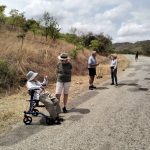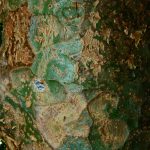TREE LIFE 522
FEBRUARY 2024
FUTURE EVENTS
There was some confusion over the main outing in January, which was eventually cancelled, my apologies. To help me put down on paper what is planned, here are the planned events:
First Saturday of every month: the National Botanical Gardens at 8.30 am;
Third Sunday morning of alternate months: (Feb, Apr, Jun, Aug 2024 etc) at a venue TBA;
Fourth Saturday afternoon of alternate months: (Mar, May, Jul, Sep 2024 etc) at a venue TBA;
So please diarise and keep them free, however these may be changed. Other ad hoc outings may be planned.
Since inclement weather or other issues may vary our plans, please join our WhatsApp group (Tony Alegria on 0772 438 697 ) for last minute updates.
PLANNED EVENTS:- FEBRUARY

Map to Gilmore Drive
Saturday 3rd February 2024:- visit to the National Botanical Gardens. Meet at 8.30 in the main car park and join us for an interesting morning with the trees we can see there.
Sunday 18th February 2024:- Anthony Manning has kindly invited us to his property at 12 A Gilmore Drive in Hogarty Hill. Following Google Maps shows the map below. 12A is at the end of the road.
REPORTS FROM PREVIOUS OUTINGS
There are a number of these so I hope that this month is a bit of a “catch up”.
A VISIT TO 131 ENTERPRISE RD (THE FORMER HOME OF ANN SINCLAIR), 25TH NOVEMBER 2023
Text by Tony Alegria and photos by Tony Alegria and Jim Dryburgh
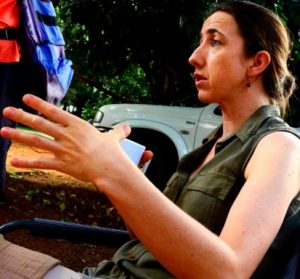
Beth from MyTrees Trust
Only eight of us turned up for the afternoon tree walk which began with tea, coffee and eats kindly supplied by Ann Sinclair. She owns the property and many years ago planted many trees, the majority of which have matured and become pretty big. However, there are a few “runts” which just didn’t grow very well for whatever reason.
Present were the ladies: Ann Sinclair and Kassy Robbie, the men were: Ian Riddell, Jan van Bel, Jim Dryburgh, Karl van Laeren and me. Beth Goodwin then arrived, paid subs to become a new member and then gave us a short talk on what the MyTrees Trust are doing. There may be some area where we can help each other.
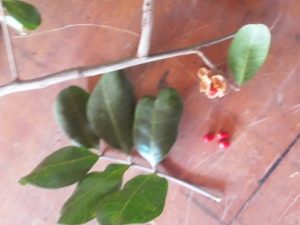
Cupaniopsis anacardioides -Tuckeroo
We looked around at the vast number of trees and I will only comment mainly on the ones we couldn’t identify! I took some specimens to Mark and there is still only one mystery tree to be identified.
The “Israeli tree” turned out to be a Cupaniopsis anacardioides. With common names Tuckeroo, carrotwood or beach tamarind and is native to eastern and northern Australia.
Note from GOOGLE – Speciality Trees: This is a compact tree with a non-invasive root system. Its cream flowers make it a favourite tree for birds too.
The specimen below with the white flowers and white sap is one of the toad trees, most likely to be Tabernaemontana ventricosa.
The tree with single leaves and flattened green fruit with a strange dark appendage was the Apodytes dimidiata . Birds-eye. Once ripe the fruit is black and the aril is red.
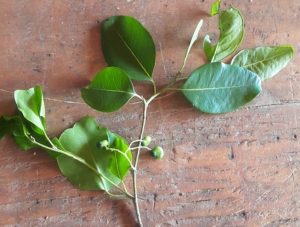
Apodytes dimidiata
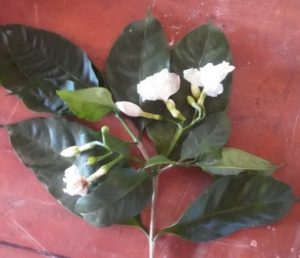
Tabernaemontana ventricosa-query.
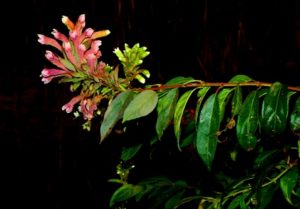
“Miss Tree” tree
The one “Miss Tree” tree is the adjacent red flowers one which had Combretum type fruit with five wings. But the flowers were Cestrum looking!
Editor’s Note: From Mark – This is certainly a Combretum, probably belonging to the now disused genus, Quisqualis, but the exact species is not yet known.
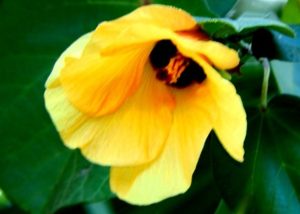
Hibiscus tiliaceus
It was good to see the Hibiscus tiliaceus again. Sea hibiscus with its yellow flowers and coppery leaves. It appears to be native to most of the tropics worldwide. This species of Hibiscus is very well suited to coastal environments as it tolerates salinity and water logging.
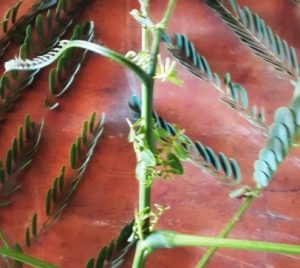
Stipules on a young Delonix regia
Another interesting finding were the stipules on a young Delonix regia. Flamboyant with once and sometimes twice pinnate stipules. Mark and I had a look at the stipules on a mature tree and sure enough they are compound!
Our thanks to Ann and Beth for a fun afternoon of discovery.
NATIONAL BOTANICAL GARDEN OUTING 2ND DECEMBER 2023
Text by Tony Alegria Photos by Jim Dryburgh
On a hot sunny day we had the best turn out for a short morning of botanizing in a very long time, present were five ladies and nine gents. One unfamiliar face was Rhett Butler who has been a member of the Tree Society for quite a while. He has a well treed garden which we have visited before and he has invited us to his home again – many thanks Rhett. We are always looking for different venues so if you have a well treed garden or know of someone who has and is willing to host us, kindly let us know.
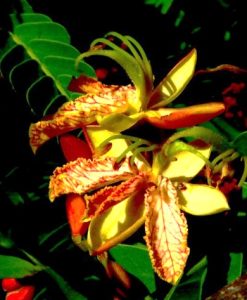
Tamarindus indica
The mission for the morning was to look at any tree in flower and anything else which caught the eye! We first looked at a tamarind tree, Tamarindus indica, which we thought was on its “last legs” about a year ago, so we moved the label to another. Surprisingly, the tree was in full leaf and flowering profusely. These are single flowers and there were two pods high up. The other tamarind tree nearby was also flowering well but difficult to see among the other trees. The other tree we had moved the label to was still in bud and about to flower.
Next we looked at the Rothmania manganjae which was covered in flower just two week ago, but now only the dried up remains were to be seen.
Nearby was a tree I have never seen in flower before, a Terminalia sambesiaca, a River terminalia with racemes of white flowers. In its shade was what looked like a coffee plant with attractive young looking bright green ribbed fruit so it must have flowered fairly recently.
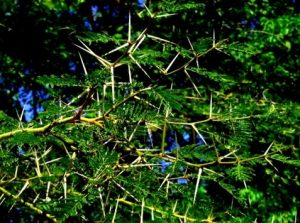
Acacia xanthophloea
The Acacia xanthophloea had also flowered fairly recently but what caught the eye was the unusual pods that were heavily constricted between the seeds. Just four years ago, this tree was so small we had to hang the label on it as the stem was too thin to take a nail!
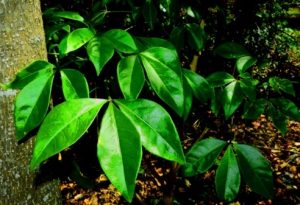
Cladostemon kirkii
The Cladostemon kirkii, the Three-finger bush, was not in flower but there was one knobkerrie fruit with quite an angle in its stalk. The most obvious feature of this bush is the fruit so the common name doesn’t make any sense. The leaves are distinctly trifoliolate.
There were two Albizias in flower, an A. versicolor and an A. harveyi, like all Albizias they have shaving brush flowers – no petals, just stamens.
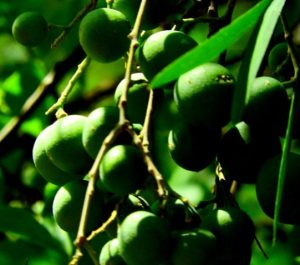
Boscia salicifolia
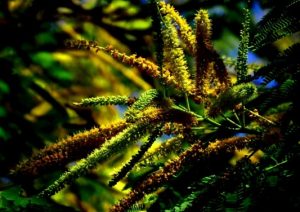
Entada abyssinica
The Entada abyssinica, the Tree Entada (left) was in full flower – creamy coloured terminal inflorescence with many spikes. The big flat pods are rather weird as each seed has its own segment of the pod and breaks off individually.
Another first for me was seeing the grape sized fruit of a Boscia salicifolia (right), so that tree had also flowered this season.
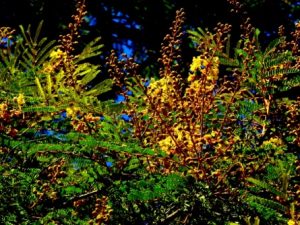
Peltophorum africanum
The last trees we saw in flower were the Peltophorum africanum . African wattle with their bright yellow flowers.
Noted during the morning was a rather large, good looking, Msasa with a broken branch, high up in the tree, from the storm we had in early November. Also noted was how “sick” the Anthocleista grandifloras were looking – these are pretty old and must be on their “last legs”!
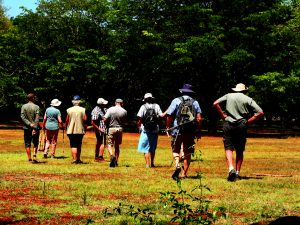
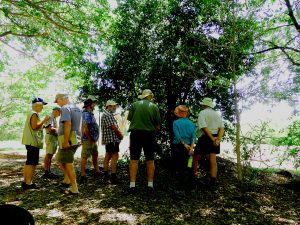
Never in a single straight line or a single group!
 NATIONAL BOTANICAL GARDEN OUTING 6TH JANUARY 2024
NATIONAL BOTANICAL GARDEN OUTING 6TH JANUARY 2024
Text by Mark Hyde, photos Mark Hyde, Jim Dryburgh and Frances Morris
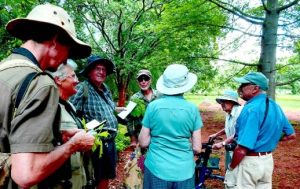
First walk in the Botanical gardens for 2024
Seven people turned up for this walk, namely Ann Sinclair, Jim Dryburgh, Meg Coates Palgrave, Ryan Truscott, Peter and Frances Morris and me. In the absence of Tony, still laid low by Covid, I was the leader. The Botanic Garden was looking magnificent after all the rain with the green trees and rapidly developing ground flora of herbaceous plants.
Before we started the walk, there were some specimens from elsewhere to identify. Ann had brought Diospyros senensis, with nicely fruiting “acorns”, from near Mongwe in the Zambezi Valley.
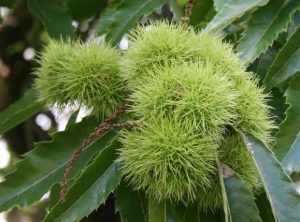
Castanea sativa – Sweet (or Spanish) Chestnut
Meg had some prickly fruits from near Juliasdale; these were Castanea sativa, the Sweet (or Spanish) Chestnut. This exotic species is native to Europe (the Mediterranean region) extending to the Caucasus. It is very commonly planted in the UK as I well recall from my youth, but in my experience, this is a rare tree in Zimbabwe. In fact, I only have seen it twice, once in the Vumba by the road down to Seldomseen and it also occurs in a garden in Basset Crescent, Harare, near the corner with Carsberg Avenue.
Peter and Frances had brought a strange-looking plant specimen from their garden which had self-seeded in a constructed wetland that treats their kitchen wastewater. This had broad alternate leaves, most of which were peltate and with the stems bearing bristly hairs which were reddish towards the apex of the stem.
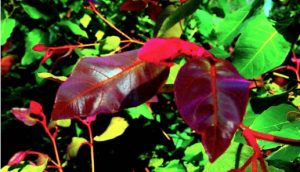
Corymbia torelliana – young leaves
Following a hunch, we compared this with plants of Corymbia (Eucalyptus) torelliana which fortunately grows near to the carpark and the match was excellent.
It was a considerable surprise that a eucalypt could have peltate leaves and the bristly hairiness was also unexpected. C. torelliana is also unusual in that trees mostly bear juvenile or intermediate leaves and adult leaves are not often seen. The trees in the Botanic Garden had an understorey of young plants but it was not clear whether these were seedlings or whether they were suckers.
On then to the walk itself and we came across a Karomia tettensis, Northern Chinese-hats.
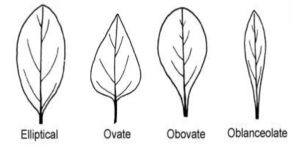
Leaf shapes to confuse!
Frances mentioned the specimen of this from Jecha (on the Zambezi near Chirundu) which she had shared on WhatsApp, the leaves of which were rounded without any lobes. On the specimen in the Botanical Gardens, the leaves were completely different with almost all having large angular lobes near the apex, although a few unlobed leaves were found. There is obviously remarkable leaf variation in this species.
Editor’s note: Reference: botanybrisbane.com
The blades can be elliptic, widely ovate, obovate or oblanceolate.
Don’t make my mistake and confuse Tettensis and tetanus. Tettensis indicates it comes originally from the province of Tete!
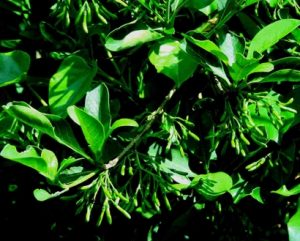
Pavetta gardeniifolia
Pavetta gardeniifolia, the Stink-leaf bride’s-bush, is a common species around Harare. It has black bacterial nodules in the lamina, white flowers and the leaves are slightly foetid when crushed.
There are two varieties recognised:
var. gardeniifolia in which the inflorescence branches are hairless; and
var. subtomentosa in which the inflorescence branches are hairy. Tomentose is a specific type of hairiness which consists of a dense felty hairs; ‘sub’ tomentose i.e. ‘slightly’ or ‘somewhat’ tomentose.
I have known vaguely of these varieties for years but until recently have never tried to record them.
A visit to Greystone Nature Preserve a few days ago produced 4 separate shrubs, all of which were var. subtomentosa; in the Mukuvisi Woodland, I saw one specimen also subtomentosa. On this occasion in the Botanic Garden, the first plant we came across was also subtomentosa but nearby was the first var. gardeniifolia I had ever seen. The distinction is easy to apply even with the naked eye, but these varieties do not seem to be distinguished by ecology; the distinction appears to be a fairly minor genetic difference.
I would welcome any further records of these varieties should anyone be interested in recording them in more detail.
The Dichrostachys cinerea, Chinese lanterns, Sickle bush, was in flower. Generally we record this to species level only, but this has quite complex variation at the subspecies and varietal level, specifically there are 3 subspecies in Zimbabwe and a number of varieties. One that is fairly easy to recognise is subsp. nyassana, which we came across on the walk. This has large leaves with, technically, the leaflets wider than 2 mm across. Subsp. africana is the commonest subspecies but it’s not so easy to separate the varieties. This would be another interesting project to pursue in order to establish which of these entities occur.
Generally, January is not a month in which many tree species flower. However, there was a large specimen of Carissa edulis (spinarum) covered in flowers.
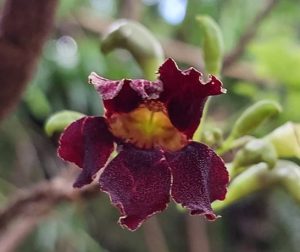
Markhamia zanzibarica
Also in flower was Markhamia zanzibarica, the Maroon bell-bean, with its unusual-looking maroon flowers.
In the area near the lake are several specimens of Chionanthus battiscombei. Originally planted in the Botanic Garden, this species is now spreading around the Garden under its own steam. It is also increasingly being planted around Harare, so we come across it quite frequently. It can be recognised by the opposite simple leaves which are completely hairless apart from the hair-tuft domatia beneath.
Peter had brought the first edition of Meg’s book – more portable than later heavier editions – and from time to time we had to rack our brains to remember the old names. Karomia was Holmskioldia and Chionanthus was Linociera!
In the woodland understorey was a small shrub (too small to qualify for inclusion in Meg’s book!) with opposite leaves and white flowers in tight heads. Like Pavetta, the leaves have black bacterial nodules readily observable when the leaves are held up to the light. This was Psychotria kirkii. We have nine Psychotria taxa in Zimbabwe and all but this one and P. pumila are confined to the Eastern Highlands in forests or forest edges. This species comes out into the savanna woodlands and is fairly frequent around Harare.
The question came up as to what the origin of the name Psychotria is. Apparently, it is from the Greek word psyche meaning life, hence life-giving, referring to the healing properties of some species.
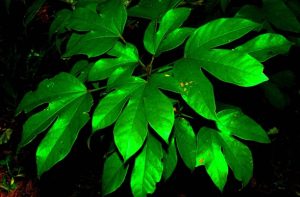
Three lobed Cola millenii
Just by the path is a species from West tropical Africa, Cola millenii. Its three-lobed leaves are very different to our native Cola greenwayi whose leaves are unlobed.
Vepris nobilis, the Giant cherry-orange, formerly Teclea nobilis, is another species like the Chionanthus which is self-seeding around the Gardens, presumably bird-sown. Until recently our botanical literature distinguished between Teclea (with 4 stamens) and Vepris with 8. However, all our species of Teclea have now been placed in Vepris. These species are not easy to identify, and it is helpful to have flowers to enable the stamens to be counted; in this case, flowers were found, and the number of stamens was four, which was correct for a former Teclea.
Altogether an interesting walk with an enthusiastic group of members.
BACK TO 2023 – SOME SHORT NOTES
POINTS OF INTEREST FROM THE VISIT TO KANYEMBA:
by Mark Hyde
Introduction
Details of the events and people who made the Kanyemba trip so special have already been written up in Tree Lifes 520 and 521, together with details of the habitats visited and the plant species seen.
This article contains a discussion of any botanical aspects which in my view were particularly noteworthy.
General comments
The Kanyemba area and the lodge where we stayed was a completely new area to me, having never been to Guruve or anywhere on the road north of that before. The area is difficult to access and at a very low latitude, c. 330 m, by Zimbabwe standards. As with the Gokwe trip in April a collection of plant specimens was made, and these were identified as far as possible by Meg and me at the National Herbarium. Ian Riddell posted images on iNaturalist and these provided further identifications.
A spreadsheet of all the records made is available and will be circulated to all those who attended.
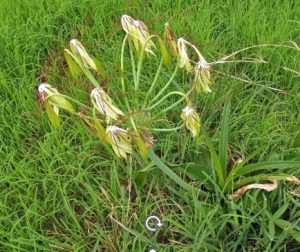
Crinum subcernuum – photo Ian Riddell
Crinum subcernuum – new to Zimbabwe
Perhaps the most interesting find was the species of Crinum in damp ground by the road leading to the Lodge. The flowers had gone over slightly and all the petals which were white with a red central vein were reflexed. Photographs were uploaded to iNaturalist [1] by Ian Riddell and these were identified by Robert Archer. It appears this is the first record for Zimbabwe. The species has been recorded before from the lower stretches of the Zambezi River in Mozambique so it is quite plausible that the species might just creep into Zimbabwe in this low-latitude northeastern corner.
As a general principle, searching for new species in any specific area is probably best carried out on the edges, especially a rather remote area such as Kanyemba. As we drove closer to the Lodge though the dry miombo woodland areas south of the Zambezi, three species of plant immediately caught our eye.
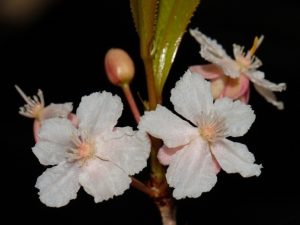
Brackenridgea arenaria
Brackenridgea arenaria – Sand Brackenridgea
We saw plenty of this small dainty ochna-like shrub with its white or pink flowers. It belongs to the same family as Ochna but its generic position seems to fluctuate between Ochna and Brackenridgea; currently Kew’s Plants of the World Online puts it in Brackenridgea. It mainly occurs in northern and western parts of Zimbabwe including areas of Kalahari sand and I had never seen this very attractive species before.
However, in the National Herbarium there is a specimen of it from Mount Pleasant in Harare, collected by FC Greatrex in 1945. This shows that sometimes there is no need to travel to find new plants; you just need to look more carefully in your local area. Mind you, I have never seen it in or near Harare either.
This example is similar to the Polygala kalaxariensis which we saw in the Mafungautsi Forest near Gokwe which was completely new to me, but which also has been reported from Harare.
Incidentally, the generic name Brackenridgea commemorates William Dunlop Brackenridge, 1810-1893, Scottish-born American horticulturist.
Xylotheca tettensis var. macrophylla – Northern African dog-rose
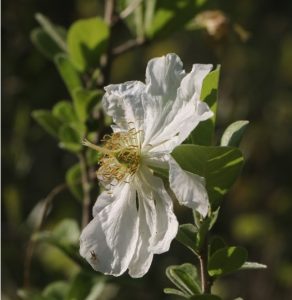
North African Dog Rose
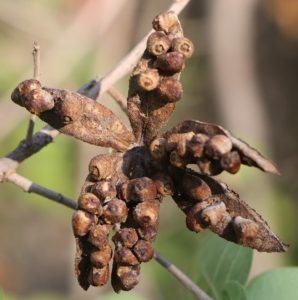
Xylotheca tettensis – dried fruit of the dog rose
The large white flowers of this shrub were very noticeable and were seen frequently. This is a rare sight in Zimbabwe; the variety is much more common across the border in Mozambique and just creeps into Zimbabwe in the extreme NE and SE. The fruits split into 5 widely spread lobes.
This is a very attractive shrub and might even have horticultural potential; indeed a related species X. kraussiana is cultivated in South Africa.
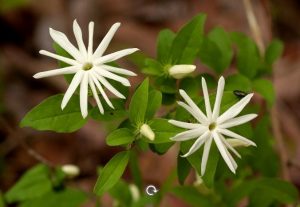
Jasminum stenolobum – photo by Bart Wursten and Flora of Zimbabwe
Jasminum stenolobum
This species is not particularly a rarity, but we saw it several times as a low-growing shrub in the woodland understorey where it was covered in large white flowers making quite a show. The flowers are somewhat unusual in possessing a large number (9-13) of lobes; typically most dicotyledonous flowers have 4-5 lobes or petals. Unfortunately the only time I tried to photograph it, all the flowers were closed, so the image is taken from the Flora of Zimbabwe website. Jasminum stenolobum has simple leaves; in the riverine vegetation by the Lodge there was Jasminum fluminense, (River jasmine) which has compound leaves with 3 leaflets and rather smaller less spectacular white flowers.
Brachystegia manga
The work done by Cathy Sharp and Meg on this genus has shown that it is not at all an easy genus taxonomically especially when one goes out of one’s comfort zone. However, Meg and I are certain that despite every effort, no specimens of Brachystegia manga were seen on the trip. A specimen collected by Karl as a possibility was, in our opinion, B. allenii, the Escarpment brachystegia which we saw quite frequently.
Limnobium laevigatum – the Amazon Frogbit
Although already reported on by Ian Riddell [2], this was a very interesting discovery. The plants were both floating in the Zambezi as well as in thick concentrations in the riverine pools near the Lodge. This is a significant extension of the range eastwards along the Zambezi and although there are as yet no records from Mozambique, surely some plants will have floated down the river into that country. This is a rapidly spreading invasive species, native to South America.
Pinnate-leaved trees
At the riverside boat stop on 4 November on the slope above the Acacia robusta subsp. clavigera, there were three species of tree legume with 1-pinnate leaves. One was clearly Xeroderris stuhlmannii but there was much debate about the other two at the time. Specimens were taken into the National Herbarium and Meg and I attempted to identify them – sadly, no firm conclusions were reached. We thought that despite the differences, the two trees were of the same species, but the group of potential species involved have quite variable characters. In the end the best match was Philenoptera bussei, but this is not absolutely certain.
Other species of interest
The roadside colony of flowers of Amorphophallus attracted a lot of interest. Meg and I identified this as Amorphophallus abyssinicus subsp. unyikae, but these species are not easy and A. mossambicensis is very similar. Unfortunately, there are no specimens of the latter for comparison in the National Herbarium.
Unidentified species
One or two plants remain unidentified at this stage, for example the unusual sedge which dominated the salt pan. Hopefully, names will be obtained for these in due course.
Finally, I would like to add a personal thank you to Frances Morris for organising the trip and to all the attendees, who made it such a very interesting and stimulating occasion.
References
[1] Crinum subcernuum on iNaturalist, https://www.inaturalist.org/observations/190382975. [2] Limnobium laevigatum. Adventures on the river. Ian Riddell. Tree Life: 521: 10.SHORT NOTES
I have extracted the recent photos and discussions which I found interesting from the Tree Society WhatsApp page . I hope you enjoy them.
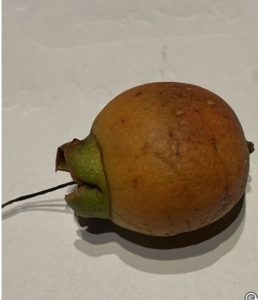
Unknown fruit shell
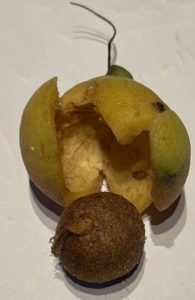
Unknown fruit innards
Karl van Laeren asked: Found this fruit under a fruit eating bat roost. Almost 40 mm in size. Any idea of the genus Maybe an exotic plant?
Mark Hyde replied: I wondered about Garcinia livingstonei but the calyx on yours looks too big. Perhaps a species of Diospyros?
Karl: Location:- So bats normally feed a short way from the collecting tree. Borrowdale Brook is a short way from me.
Result: Various contributions as to possible location of tree but no firm conclusion.
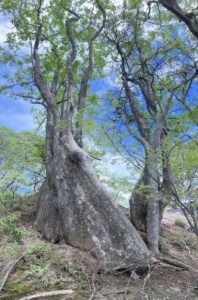
Lannea schweinfurthii – photo by Di Drummond
EDITORS COMMENTS: I hope you enjoy the short notes above, note they are purely my choice! If anyone has any other short notes not highlighted in WhatsApp, please let me have them. My contact details below.
TREE SOCIETY COMMITTEE AND CONTACTS
Chairman Tony Alegria tonyalegria47@gmail.com 0772 438 697
Honorary Treasurer Bill Clarke wrc@mweb.co.zw 0772 252 720
Projects Jan van Bel jan_vanbel@yahoo.com 0772 440 287
Venue Organiser Ann Sinclair jimandannsincs@zol.co.zw 0772 433 125
Committee Member Ryan Truscott ryan.kerr.truscott@gmail.co 0772 354 144
Secretary Teig Howson teig.howson@gmail.com 0772 256 364
Tree Life Editor Linda Hyde Lmharwin@pentact.co.zw 0772 232 075
Tree Society Website https://treesociety.org.zw/
Tree Society Facebook https://www.facebook.com/groups/ztreesociety/
Flora of Zimbabwe: https://www.zimbabweflora.co.zw/
Flora of Tropical Africa: https://plants.jstor.org/collection/FLOTA


